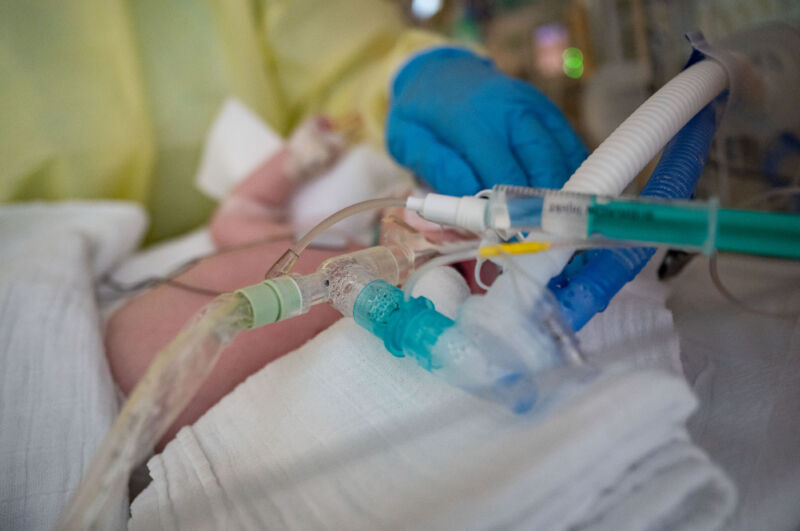
With SARS-CoV-2 still circulating and seasonal viruses, including flu and RSV, making up for lost time during the pandemic, the US is beset by respiratory illness. And things could get worse as more holidays and associated gatherings approach, health officials warned Monday.
“This year’s flu season is off to a rocky start. Flu is here, it started early, and with COVID and RSV also circulating, it’s a perfect storm for a terrible holiday season,” said Sandra Fryhofer, president of the American Medical Association and adjunct professor medicine at Emory University School of Medicine, said today in a news conference held by the Centers for Disease Control and Prevention. “In recent years, COVID protective measures have also prevented the spread of flu and other respiratory infections, but we’re really not in that bubble anymore.”
Cases of flu-like illnesses (ILIs) are on the rise across the country, with 47 states seeing “very high” or “high” levels of activity, according to the latest CDC data. The agency estimates there have been at least 8.7 million illnesses, 78,000 hospitalizations, and 4,500 deaths from the flu.
Increases
The numbers point to an exceptionally early flu season, although not necessarily an exceptionally severe one. ILI cases and hospitalizations are higher for this point in the season than they have been at this point in any previous season since the 2010–11 season. But hospital admissions have not reached the peaks of previous seasons.
Still, there are signs that the season could be particularly bad and early. The GGD reports that flu vaccination figures are lagging behind this year, especially among children and pregnant people. The early season and slow vaccination has led to a jump in hospital admissions. The number of new hospitalizations with laboratory-confirmed cases of the flu nearly doubled in the week ending Nov. 26 from the previous week, with approximately 19,600 hospitalizations in the week ending Nov. 26 compared to 11,000 in the week before.
COVID-19 is also springing up. While transmission in the U.S. has largely ground to a halt in recent months, the Thanksgiving holiday appears to have sparked an uptick, with hospital admissions rising 28 percent over the past two weeks to a daily average of 35,600, according to data tracking by The New York Times. York Times. Adoption of the updated COVID-19 booster, which has proven effective in increasing protection against infection, remains dismal, with only 12.7 percent of eligible Americans getting their shot.
Meanwhile, the RSV virus (respiratory syncytial (sin-SISH-uhl) virus) has been on the rise in young children, with cases skyrocketing in recent weeks, filling children’s beds and overwhelming hospitals. Today CNN reported that some hospitals are facing a shortage of medical cribs amid the rise in respiratory illnesses. On Friday, New Mexico announced a public health emergency ordinance requiring all hospitals in the state to participate in a “hub and speak” model, managing resources and transferring patients to where they can best be treated.
“This public health emergency order is now needed as hospitals and emergency rooms are operating beyond their authorized capacity due to an increase in respiratory viruses and are now experiencing unsustainable pressure on health care providers,” the New Mexico Health Department said.
Wave beyond wave
Good news is that RSV infections may have already peaked in some parts of the country, namely the South and Southeast, and may be leveling off in the Mid-Atlantic, New England and Midwest, CDC Director Rochelle Walensky said in today’s press conference. .
“While this is encouraging, respiratory viruses continue to spread at high levels nationwide and even in areas where RSV may be declining; our hospital systems continue to be stretched with a high number of patients with other respiratory illnesses,” she warned.
Walensky urged Americans to get vaccinated. “First of all, get vaccinated. There are vaccines for two of the three viruses discussed today,” she said, referring to vaccines for flu and COVID-19 (no RSV vaccine is currently available). She also urged other health measures, such as covering coughs and sneezes, washing hands, staying home when sick, better ventilation in homes and workplaces, and wearing a high-quality mask.
Currently, CDC masking recommendations are based only on transmission levels of SARS-CoV-2. However, when asked today whether the agency would consider basing the recommendation on the transmission of respiratory disease in general, Walensky said the agency was “actively looking into it.” But in the meantime, she noted, “one shouldn’t wait for CDC action to put on a mask.”

